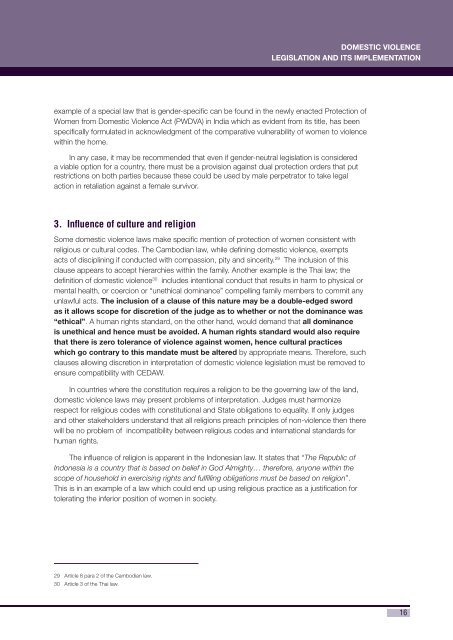Domestic Violence Legislation and its Implementation
Domestic Violence Legislation and its Implementation
Domestic Violence Legislation and its Implementation
Create successful ePaper yourself
Turn your PDF publications into a flip-book with our unique Google optimized e-Paper software.
DOMESTIC VIOLENCE<br />
LEGISLATION AND ITS IMPLEMENTATION<br />
example of a special law that is gender-specifi c can be found in the newly enacted Protection of<br />
Women from <strong>Domestic</strong> <strong>Violence</strong> Act (PWDVA) in India which as evident from <strong>its</strong> title, has been<br />
specifi cally formulated in acknowledgment of the comparative vulnerability of women to violence<br />
within the home.<br />
In any case, it may be recommended that even if gender-neutral legislation is considered<br />
a viable option for a country, there must be a provision against dual protection orders that put<br />
restrictions on both parties because these could be used by male perpetrator to take legal<br />
action in retaliation against a female survivor.<br />
3. Infl uence of culture <strong>and</strong> religion<br />
Some domestic violence laws make specifi c mention of protection of women consistent with<br />
religious or cultural codes. The Cambodian law, while defi ning domestic violence, exempts<br />
acts of disciplining if conducted with compassion, pity <strong>and</strong> sincerity. 29 The inclusion of this<br />
clause appears to accept hierarchies within the family. Another example is the Thai law; the<br />
defi nition of domestic violence 30 includes intentional conduct that results in harm to physical or<br />
mental health, or coercion or “unethical dominance” compelling family members to commit any<br />
unlawful acts. The inclusion of a clause of this nature may be a double-edged sword<br />
as it allows scope for discretion of the judge as to whether or not the dominance was<br />
“ethical”. A human rights st<strong>and</strong>ard, on the other h<strong>and</strong>, would dem<strong>and</strong> that all dominance<br />
is unethical <strong>and</strong> hence must be avoided. A human rights st<strong>and</strong>ard would also require<br />
that there is zero tolerance of violence against women, hence cultural practices<br />
which go contrary to this m<strong>and</strong>ate must be altered by appropriate means. Therefore, such<br />
clauses allowing discretion in interpretation of domestic violence legislation must be removed to<br />
ensure compatibility with CEDAW.<br />
In countries where the constitution requires a religion to be the governing law of the l<strong>and</strong>,<br />
domestic violence laws may present problems of interpretation. Judges must harmonize<br />
respect for religious codes with constitutional <strong>and</strong> State obligations to equality. If only judges<br />
<strong>and</strong> other stakeholders underst<strong>and</strong> that all religions preach principles of non-violence then there<br />
will be no problem of incompatibility between religious codes <strong>and</strong> international st<strong>and</strong>ards for<br />
human rights.<br />
The infl uence of religion is apparent in the Indonesian law. It states that “The Republic of<br />
Indonesia is a country that is based on belief in God Almighty… therefore, anyone within the<br />
scope of household in exercising rights <strong>and</strong> fulfi lling obligations must be based on religion”.<br />
This is in an example of a law which could end up using religious practice as a justifi cation for<br />
tolerating the inferior position of women in society.<br />
29 Article 8 para 2 of the Cambodian law.<br />
30 Article 3 of the Thai law.<br />
16

















